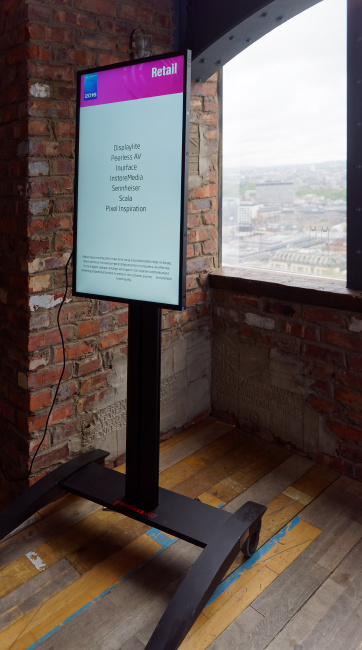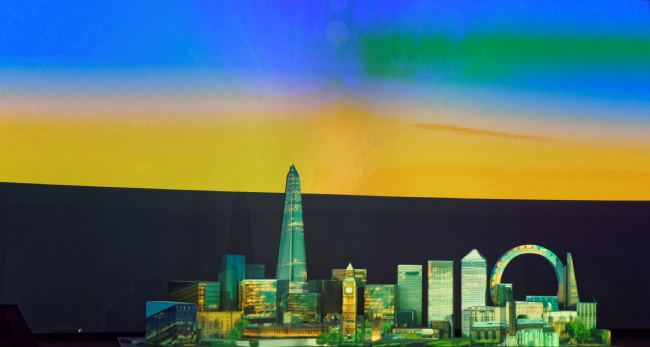The NEC Showcase took place this year at the Millbank Tower. The nearest underground station was Westminster, beside the Houses of Parliament in London. I was surprised to see a band and lots of tourists and thought that NEC had gone to extreme lengths to welcome delegates, but it turned out to be the opening of Parliament, attended by the queen and the UK’s politicians.
Anyway, the national event meant no taxis, or even buses, so we had a (damp) walk down to the event which took place on the 28th and 29th floors of the tower – with iconic views along the Thames to Westminster. The location seemed to be a little less spacious than previous events, but there was a business like atmosphere and plenty of visitors.
 Peerless supplied the stands and mountsCompared to previous years, NEC really didn’t highlight its own products and focused strongly on its partners (there were around 30 companies represented there) and their solutions. Peerless AV supplied all the stands and mounts for the many displays at the event – I estimated 208 displays in total in typical use cases. They were arranged about a number of the major vertical markets that NEC markets into. The areas were:
Peerless supplied the stands and mountsCompared to previous years, NEC really didn’t highlight its own products and focused strongly on its partners (there were around 30 companies represented there) and their solutions. Peerless AV supplied all the stands and mounts for the many displays at the event – I estimated 208 displays in total in typical use cases. They were arranged about a number of the major vertical markets that NEC markets into. The areas were:
- LED Gallery
- The NEC Experience
- Corporate
- Retail
- Transport
- Broadcast & Media
- Education
- Command & Control
The event started with the “NEC Experience” which used a combination of projection mapping in a cinema setting onto a model of the London skyline using two projectors, with others showing the sky. Down the side of the theatre, a range of flat panels were used with complementary content. The accuracy of the mapping of the image onto the model was very accurate, it seemed, although we were observing from some distance. After that, we went around to talk to the partners…

The first partner we spoke to was DisplayLite, a UK-based touch integrator. The company was showing a 55″ UltraHD touch table based on an NEC display fitted with a procap touch module using the Cima Nanotech material, using a glass touch module from the Cima/Foxconn joint venture. Performance was good and it’s unusual to see such high resolution on a relatively small display which allows a lot of detail to be seen. DisplayLite is also working with Touchtech Lima software for this application.
Touchtech also has new Vendo software for point of sale applications. Retailers often find that simply putting web sites into stores can get some engagement from customers, but often the transaction is abandoned before a purchase is complete. Therefore, Touchtech has developed more ‘kiosk-like’ (our phrase) software that makes for a simpler and more involving retail experience. DisplayLite is offering this in regular displays and also in 32″ displays fitted with half-silvered mirrors. The company is working on a system that will use a motion detector and power-up the display when a consumer comes close to the mirror. If they are further away, it just looks like a regular mirror.
Hiperwall had a very impressive demonstration, but the only news since ISE was a minor update to the V4.0 software that it announced in Amsterdam. This means that the company’s software can now support Intel GPUs as well as the Nvidia GPUs that it could previously be used with.

U-Touch had several displays fitted with touch at the event, on two different floors. The first one that we looked at was an 84″ UltraHD procap touch table using the Cima Nanotech material. This allows up to 32 touches. On the other floor, the company had a 65″ UHD NEC monitor fitted with FlatFrog FTIR technology. That meant very good optical perfomance, better than Cima, but requiring very high quality glass that is not available in the larger sizes such as 84″.
FlatFrog (with U-Touch) also had a demonstration of a new version of its technology which can use ‘any’ glass, including those with coatings. The demonstration display at the event had a very smooth finish, minimising ‘finger burn’. This version has been developed to work well with Windows 10 which needs to be able to work with a pen or with a finger, or the side of the hand (as an eraser). The new version does this, opening up the market for Windows-based systems. Performance was very good, although unlike the previous version, pressure is not detected.
Matrox was showing its Mura IPX system which can capture UltraHD content and display it on video walls and which we reported on at ISE.
 Dot Origin makes the NFC and Bluetooth beacons that we saw when NEC was at the Passenger Terminal Exp in Cologne. These connect to a USB port (which could be on a media player, a smart display or an OPS-based system) and are easily supported by CMS systems, even cloud-based systems such as signagelive. We discussed the slow roll out of beacon technology and Dot Origin admitted that adoption has been slow even among those that might benefit. It is trying to help by developing applications, such as use with a FID in an airport, where flight information could be sent directly to a connected smartphone. The company’s technology goes beyond the basics of beacon transmission, and makes the bluetooth connection bidirectional. This means that, for example, travellers could request flight information just for a particular flight.
Dot Origin makes the NFC and Bluetooth beacons that we saw when NEC was at the Passenger Terminal Exp in Cologne. These connect to a USB port (which could be on a media player, a smart display or an OPS-based system) and are easily supported by CMS systems, even cloud-based systems such as signagelive. We discussed the slow roll out of beacon technology and Dot Origin admitted that adoption has been slow even among those that might benefit. It is trying to help by developing applications, such as use with a FID in an airport, where flight information could be sent directly to a connected smartphone. The company’s technology goes beyond the basics of beacon transmission, and makes the bluetooth connection bidirectional. This means that, for example, travellers could request flight information just for a particular flight.

